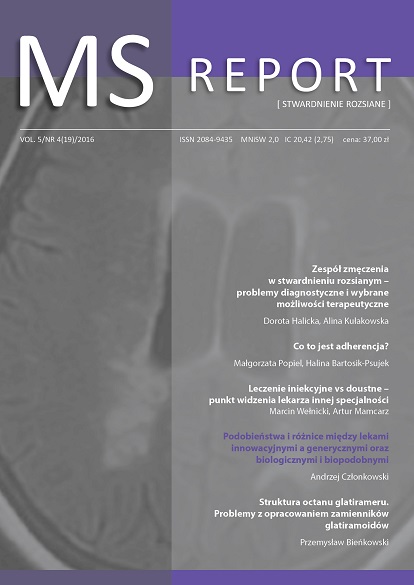Struktura octanu glatirameru. Problemy z opracowaniem zamienników glatiramoidów Artykuł przeglądowy
##plugins.themes.bootstrap3.article.main##
Abstrakt
Celem poniższego przeglądu jest przedstawienie zainteresowanym czytelnikom podstawowych problemów związanych z tworzeniem leków generycznych dla glatiramoidów.
##plugins.themes.bootstrap3.article.details##
Numer
Dział
Artykuły
Copyright © by Medical Education. All rights reserved.
Bibliografia
1. Bartosik-Psujek H.: Aktualne zasady terapii stwardnienia rozsianego. Aktualn. Neurol. 2009; 9: 132-139.
2. Zawada M.: Potencjalne czynniki patogenne w stwardnieniu rozsianym (SM). Postępy Hig. Med. Dośw. 2012; 66: 758-770.
3. Boster A.L., Ford C.C., Neudorfer O. et al.: Glatiramer acetate: long-term safety and efficacy in relapsing-remitting multiple sclerosis. Expert Rev. Neurother. 2015; 15: 575-586.
4. Oreja-Guevara C., Río J., Gobartt A.L.; Nombre del grupo de investigadores del estudio FUTURA: [Compliance of the guidelines of the Spanish Neurology Society in the treatment of patients with multiple sclerosis]. Rev. Neurol. 2015; 61: 145-152.
5. Signori A., Gallo F., Bovis F. et al.: Long-term impact of interferon or Glatiramer acetate in multiple sclerosis: A systematic review and meta-analysis. Mult. Scler. Relat. Disord. 2016; 6: 57-63.
6. Miller A., Spada V., Beerkircher D., Kreitman R.R.: Long-term (up to 22 years), open-label, compassionate-use study of glatiramer acetate in relapsing-remitting multiple sclerosis. Mult. Scler. 2008; 14: 494-499.
7. Johnson K.P.: Glatiramer acetate and the glatiramoid class of immunomodulator drugs in multiple sclerosis: an update. Expert Opin. Drug Metab. Toxicol. 2010; 6: 643-660.
8. Conner J.B., Bawa R., Nicholas J.M., Weinstein V.: Copaxone® in the era of biosimilars and nanosimilars. W: Bawa R., Audette G.F., Rubinstein I. (red.): Handbook of Clinical Nanomedicine – From Bench to Bedside. Pan Stanford Publishing, 2016.
9. Sela M.: Poly(alpha-amino acids) – from a better understanding of immune phenomena to a drug against multiple sclerosis. Acta Polymerica 1998; 49: 523.
10. Varkony H., Weinstein V., Klinger E. et al.: The glatiramoid class of immunomodulator drugs. Expert Opin. Pharmacother. 2009; 10: 657-668.
11. Dhib-Jalbut S.: Glatiramer acetate (Copaxone) therapy for multiple sclerosis. Pharmacol. Ther. 2003; 98: 245-255.
12. Rogstad S., Pang E., Sommers C. et al.: Modern analytics for synthetically derived complex drug substances: NMR, AFFF-MALS, and MS tests for glatiramer acetate. Anal. Bioanal. Chem. 2015; 407: 8647-8659.
13. Jalilian B., Einarsson H.B., Vorup-Jensen T.: Glatiramer acetate in treatment of multiple sclerosis: a toolbox of random co-polymers for targeting inflammatory mechanisms of both the innate and adaptive immune system? Int. J. Mol. Sci. 2012; 13: 14579-14605.
14. Cohen J., Belova A., Selmaj K. et al.: Equivalence of Generic Glatiramer Acetate in Multiple Sclerosis: A Randomized Clinical Trial. Glatiramer Acetate Clinical Trial to Assess Equivalence With Copaxone (GATE) Study Group. JAMA Neurol. 2015; 72: 1433-1441.
15. Schellekens H., Klinger E., Muhlebach S. et al.: The therapeutic equivalence of complex drugs. Regul. Toxicol. Pharmacol. 2011; 59: 176-183.
16. Berkowitz S.A., Engen J.R., Mazzeo J.R., Jones G.B.: Analytical tools for characterizing biopharmaceuticals and the implications for biosimilars. Nat. Rev. Drug Discov. 2012; 11: 527-540.
17. Towfic F., Funt J.M., Fowler K.D. et al.: Comparing the biological impact of glatiramer acetate with the biological impact of a generic. PLoS One 2014; 9: e83757.
2. Zawada M.: Potencjalne czynniki patogenne w stwardnieniu rozsianym (SM). Postępy Hig. Med. Dośw. 2012; 66: 758-770.
3. Boster A.L., Ford C.C., Neudorfer O. et al.: Glatiramer acetate: long-term safety and efficacy in relapsing-remitting multiple sclerosis. Expert Rev. Neurother. 2015; 15: 575-586.
4. Oreja-Guevara C., Río J., Gobartt A.L.; Nombre del grupo de investigadores del estudio FUTURA: [Compliance of the guidelines of the Spanish Neurology Society in the treatment of patients with multiple sclerosis]. Rev. Neurol. 2015; 61: 145-152.
5. Signori A., Gallo F., Bovis F. et al.: Long-term impact of interferon or Glatiramer acetate in multiple sclerosis: A systematic review and meta-analysis. Mult. Scler. Relat. Disord. 2016; 6: 57-63.
6. Miller A., Spada V., Beerkircher D., Kreitman R.R.: Long-term (up to 22 years), open-label, compassionate-use study of glatiramer acetate in relapsing-remitting multiple sclerosis. Mult. Scler. 2008; 14: 494-499.
7. Johnson K.P.: Glatiramer acetate and the glatiramoid class of immunomodulator drugs in multiple sclerosis: an update. Expert Opin. Drug Metab. Toxicol. 2010; 6: 643-660.
8. Conner J.B., Bawa R., Nicholas J.M., Weinstein V.: Copaxone® in the era of biosimilars and nanosimilars. W: Bawa R., Audette G.F., Rubinstein I. (red.): Handbook of Clinical Nanomedicine – From Bench to Bedside. Pan Stanford Publishing, 2016.
9. Sela M.: Poly(alpha-amino acids) – from a better understanding of immune phenomena to a drug against multiple sclerosis. Acta Polymerica 1998; 49: 523.
10. Varkony H., Weinstein V., Klinger E. et al.: The glatiramoid class of immunomodulator drugs. Expert Opin. Pharmacother. 2009; 10: 657-668.
11. Dhib-Jalbut S.: Glatiramer acetate (Copaxone) therapy for multiple sclerosis. Pharmacol. Ther. 2003; 98: 245-255.
12. Rogstad S., Pang E., Sommers C. et al.: Modern analytics for synthetically derived complex drug substances: NMR, AFFF-MALS, and MS tests for glatiramer acetate. Anal. Bioanal. Chem. 2015; 407: 8647-8659.
13. Jalilian B., Einarsson H.B., Vorup-Jensen T.: Glatiramer acetate in treatment of multiple sclerosis: a toolbox of random co-polymers for targeting inflammatory mechanisms of both the innate and adaptive immune system? Int. J. Mol. Sci. 2012; 13: 14579-14605.
14. Cohen J., Belova A., Selmaj K. et al.: Equivalence of Generic Glatiramer Acetate in Multiple Sclerosis: A Randomized Clinical Trial. Glatiramer Acetate Clinical Trial to Assess Equivalence With Copaxone (GATE) Study Group. JAMA Neurol. 2015; 72: 1433-1441.
15. Schellekens H., Klinger E., Muhlebach S. et al.: The therapeutic equivalence of complex drugs. Regul. Toxicol. Pharmacol. 2011; 59: 176-183.
16. Berkowitz S.A., Engen J.R., Mazzeo J.R., Jones G.B.: Analytical tools for characterizing biopharmaceuticals and the implications for biosimilars. Nat. Rev. Drug Discov. 2012; 11: 527-540.
17. Towfic F., Funt J.M., Fowler K.D. et al.: Comparing the biological impact of glatiramer acetate with the biological impact of a generic. PLoS One 2014; 9: e83757.

